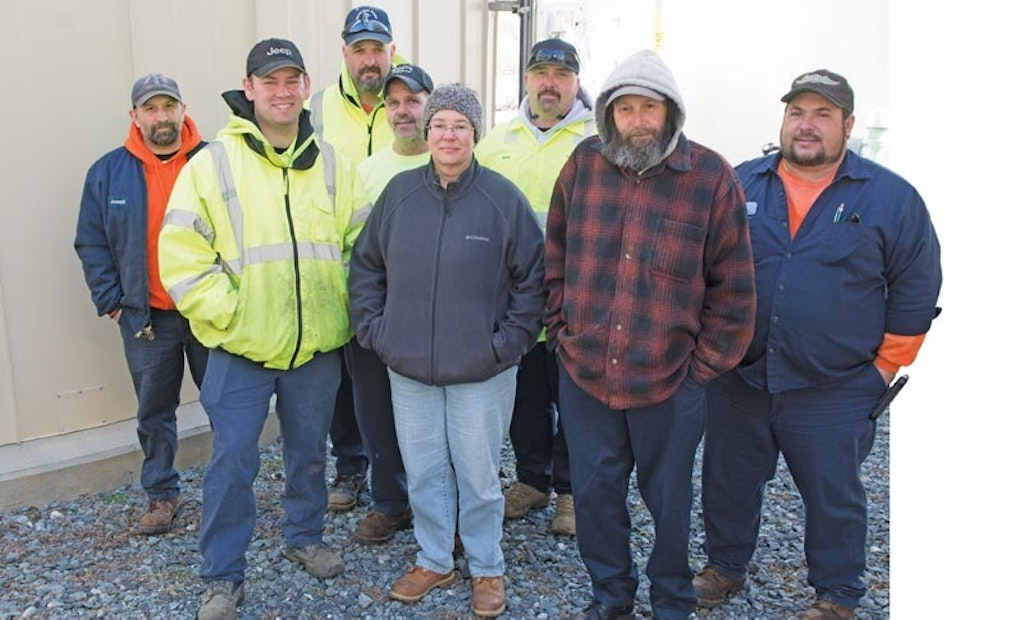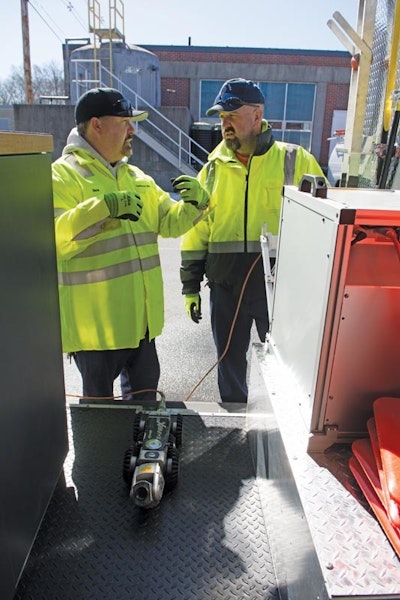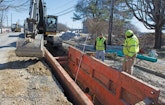
Interested in Flow Control?
Get Flow Control articles, news and videos right in your inbox! Sign up now.
Flow Control + Get AlertsBeing responsible for twins joined at the hip doesn’t phase Linda Schick of Fairhaven, Massachusetts.
She takes her duties as sewer and wastewater superintendent at the Fairhaven Water Pollution Control Facility and West Island Treatment Plant personally. “At some point, the collections system and treatment plant components stopped being objects and became family,” she says.
The members are mainly advanced senior citizens. They leak, creating huge inflow and infiltration problems. They collapse from fatigue or block structurally. Their valves creak and motors whine, but repairs are difficult because many replacement parts are no longer available.
“Almost every upstream event affects the Fairhaven plant negatively because the equipment is vintage 1987,” says Schick. “We’re not a flush community. Consequently, my team excels at working with the resources at hand.”
An unidentified individual aware of Schick’s steadfast devotion wrote on a nomination form that her “dedication to the department were assets often taken for granted, but should be rewarded by her peers.” The New England Water Environment Association agreed, giving her the 2014 Operator Award.
Moving targets
Schick’s greatest challenge is prioritizing work in a location dominated by high water. Fairhaven abuts the Acushnet River, which flows into Buzzards Bay, an arm of the Atlantic Ocean. Residential sump pumps discharging to the 75-mile collections system are the major source of inflow and infiltration.
Leaking clay pipe from the late 1800s and early 1900s, as well as newer piecemeal PVC repairs, exacerbate the condition. Stringent sewer inspections have ended poor installations, allowing Schick to complete asset management studies and determine priorities.
“It’s difficult to keep up with them,” she says. “We’re trying to replace all the clay pipe, but almost every time we attack one section of town, something fails somewhere else.” Flow studies identified 1940s to 1960s neighborhoods with asbestos concrete pipe as the greatest source of infiltration.
For many years, the lack of proper equipment stymied Schick’s efforts. “I’ve wanted a CCTV pipeline inspection system since becoming superintendent in 1988,” she says. “In 2012, we got a Quickview Zoom and ROVVER X system [Envirosight] in a Ram ProMaster van. It’s made a world of difference.”
By not hiring contractors, in-house sewer inspections save the town $1,500 to $2,000 per day, and the three full-time sewer/pump station technicians accomplish more work. As NASSCO Pipeline Assessment and Certification Program users, they produce the reports and videos accompanying repair contracts instead of hiring consulting engineers.
“All 10 employees are cross-trained on the collections system and in the two plants,” says Schick, who spent a year as a laboratory technician before advancing to her present position. She holds a Master of Biology and a Master of Business Administration, the equivalent of 10 years of experience.
Her team includes assistant superintendent Rene Robillard (28 years) and operators Jeff Furtado (15), Doug Pinard (13) and Victor Oliveira and Kyle Winderlick (five). Maintenance craftsmen Dana Hathaway (16), Joseph Bonneau (12) and Matt Manzone (four); combined heat and power operator Robert Gomes (17); laboratory technician Lee Barlow (12); electrician Ray Paczosa (26); and mechanic Joseph Frates (11) round out the team.
Heart stoppers
At least 50 percent of the collections system is unsound, and 25 percent of the pipes are clay. Some are so brittle and close to collapse that crews are afraid to use the truck-mounted jet rodder (SRECO-FLEXIBLE) before inserting the camera. Their fears are valid.
Just before a Memorial Day weekend, the rodder brought back voluminous debris as the crew flushed a 10-inch clay main. They stopped cleaning, expecting to return on Tuesday, but a section of pipe collapsed Saturday morning. Schick found a contractor who worked with the team on a point repair that took most of the holiday. Another contractor rehabilitated the entire main using lining systems from Insituform Technologies.
Winters as severe as the last two brought unique challenges. “We haven’t used the CCTV much this year because we haven’t seen the manholes for a while,” Schick says. Fairhaven received 6 feet of snow.
Fortunately, crews were able to monitor a manhole on an 8-inch clay sewer that filled regularly with grit and debris. The pipe runs under the middle of the town’s main thoroughfare. “Because there isn’t a depression in the roadbed, we believe the break is somewhere off site, and debris is washed down from it,” Schick says. “Nevertheless, this line keeps me awake at night wondering if the call will come saying a vehicle fell in.”
Spare that tree
Part of this historic seaside community’s charm is its hundreds of mature trees, guarded by protective owners who voice their concerns to the Board of Public Works when they have sewer problems. “We’re one of the few municipalities still entering homes to clean laterals,” Schick says. “It’s the board’s way of showing your tax dollars at work.”
Although the department has legal right of entry, the risk of liability is daunting. Many older homes have cellar traps with an unnavigable U-curve. Rodding would damage plumbing before ever reaching the road. Laterals often run through two or three properties, causing easement worries should the pipe break under someone else’s yard.
To defuse the situation, Schick tries to persuade owners to introduce RootX into their laterals 30 days after they are cleaned. In 2005, she began a program of installing 10 sidewalk service clean-outs per year at troublesome locations. “Ten years ago we were averaging four to five service calls per week,” Schick says. “Now we enjoy numerous weeks of blissful silence.”
Rag-goo
When the pipes aren’t calling, the 15 pump stations are gagging on rags. Most failures occur at stations with submersible grinders moving less than 50,000 gpd. Schick is unsure why they must be deragged so frequently. “I think the answer is some kind of maceration before the pumps,” she says.
Retrofitting pump stations from the 1960s and early 1970s is high on the priority list. The work includes installing choppers in most of the pumps. In addition, the three-member crew flushes and cleans major stations on a weekly cycle to prevent the accumulation of rags. Once a year, Schick hires a contractor with a vacuum truck to empty the wet wells for a thorough inspection.
“At least 50 percent of pump station and collections system maintenance is due to rags,” Schick says. “When the men are fighting them, they aren’t inspecting mains and attacking I&I. Now that I have CCTV equipment, I want a dedicated crew using it.”
Grease from numerous restaurants also helps clog sewers and pump stations. “We’re constantly switching vendors to find a degreaser that works with the aggressiveness of older products,” Schick says. “Currently, we’re experimenting with Grease-X [RootX], while trying to educate food staffs about grease interceptors and how to clean them.”
Time and tide
Rags and grease aren’t the only threats to the stations. Fairhaven averages a hurricane per year, and a major hurricane every five or six years. Power outages abound, causing trouble for remote stations abutting water. Trying to shut them down during a blow can even be life threatening. “The last hurricane hit on a full moon,” Schick says. “The high tide came in so fast we almost didn’t arrive in time, let alone get out.”
From 2010 to 2014, electrician Paczosa retrofitted all 15 stations with components and software from Mission Communications. Although not a true SCADA system, it allows operators to start and stop pumps remotely.
Paczosa is one of Schick’s invaluable people. After 26 years on the job, he knows how to bypass or jury rig things that don’t work. He reroutes wiring, retrofits parts from old pump stations to work in newer ones and has learned instrumentation. “Ray’s also a great mechanic and services our HVAC system,” Schick says. “He’s saved us tons of money.”
After the 1987 upgrade to the Fairhaven treatment plant, Schick was shocked to learn some components were not on the emergency generator. Hurricane Bob delivered the news in 1991. During the weeks it took to restore power along the coast, Fairhaven was the only community able to accept septage. Paczosa had quickly wired the septage tanks to the Caterpillar generator.
To the rescue
Wiring necessary plant components to the generator didn’t prevent all emergencies. One night during a storm, flood alarms went off in the cellar of the sludge building. When Paczosa arrived, he found 5 feet of water threatening the 50 pumps. He killed the power, then called Schick and other workers. Together, they brought in a portable pump and discovered water coming up through the drains. “We don’t know how, but with no other place for the water to go, it got into the flow equalization return and caused the flood,” Schick says.
Paczosa baked the waterlogged motors and temporarily relocated as many controls as possible upstairs. With the arrival of seed sludge, operators had the plant running in 48 hours. “Officials from the state Department of Environmental Protection were impressed,” Schick says. “Ray made it possible.” He later moved all the controls in the sludge building upstairs.
One of Schick’s proudest accomplishments, however, is digitizing the collections system using Mapsonline (PeopleGIS). As technicians put the geographic information system together, they found older sections of town completely undocumented. Today, they are moving through those zones categorizing and coding everything per PACP condition grades, enabling Schick to develop I&I and repair plans.
“Getting the camera truck is another proud accomplishment,” she says. “I believe in preventing failures rather than reacting to them. As I approach retirement, I also want to archive as much information as possible so my family is properly cared for when I leave.”








